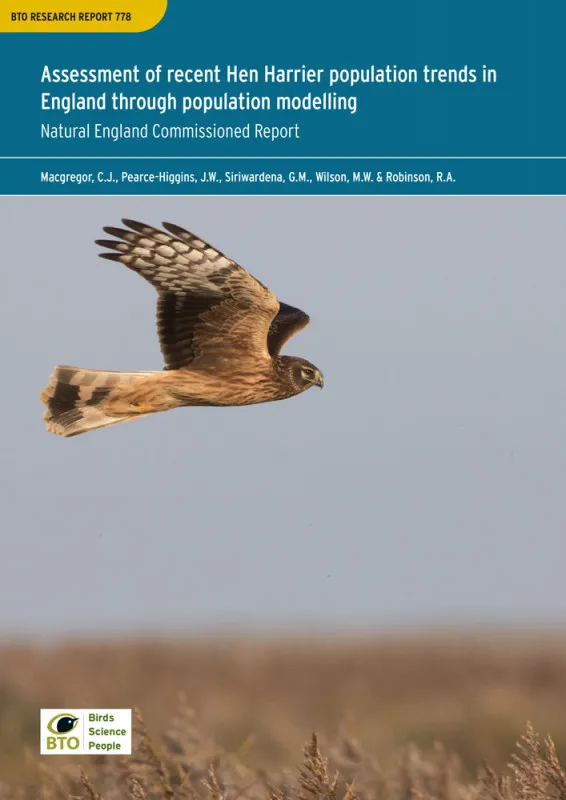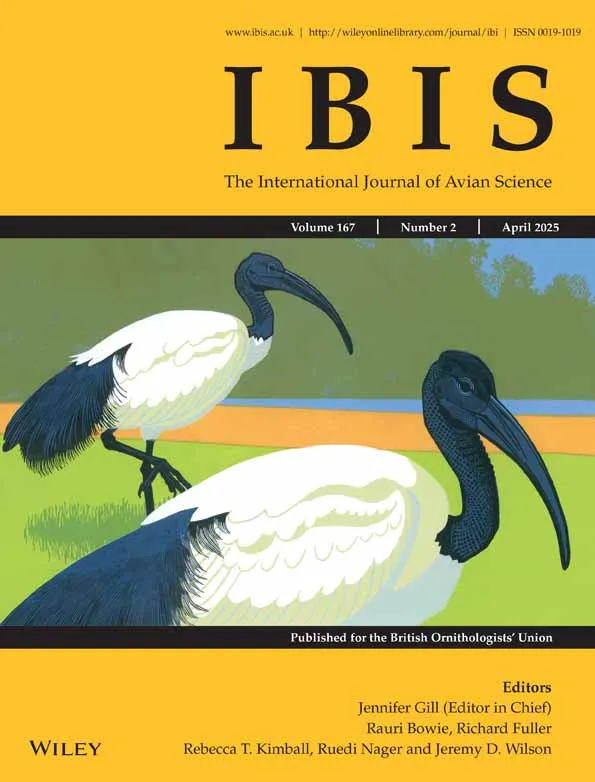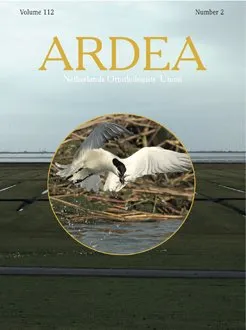BTO Research Reports are scientific papers that have been self-published by the BTO. The following is a full list of the published BTO research reports. Most are free to download, and links to Abstracts are included where possible.
Numbers missing from the list are those allocated but which were never produced or which have not been published. BTO recognises that, particularly in respect of commercially sensitive cases, a period of confidentiality is appropriate for some projects. However, in the interests of scientific development and dissemination of information, we encourage clients to permit publication as soon as it is reasonable to do so.
- If you wish to purchase a physical copy of a report please contact researchreports@bto.org.
- More information about our Annual Service reports to JNCC 1992-2005.
Assessment of recent Hen Harrier population trends in England through population modelling
This study uses a population modelling approach to explore the effects of changes in rates of productivity, survival, and settlement on population growth in the English population of Hen Harriers.

Search
Temperature sensitivity of breeding phenology and reproductive output of the Common Redstart (Phoenicurus phoenicurus)
Author: Lonero, I., Eddowes, M.J., Burgess, M.D., Pearce-Higgins, J.W. & Phillimore, A.B.
Published: 2024
One of the most obvious ways in which birds have responded to climate change is by shifting the timing of their breeding and migration. In spring, many long-distance migratory species are now arriving earlier than in the past, and most species are also nesting earlier than then used to, particularly in warmer years. But has this led to a mismatch in the timing of the breeding season and the peak availability of key food resources for breeding birds and their young, leading to a reduction in breeding success and eventual population declines?
20.11.24
Papers

Temperature sensitivity of breeding phenology and reproductive output of the Common Redstart (Phoenicurus phoenicurus)
Author: Lonero, I., Eddowes, M.J., Burgess, M.D., Pearce-Higgins, J.W. & Phillimore, A.B.
Published: 2024
One of the most obvious ways in which birds have responded to climate change is by shifting the timing of their breeding and migration. In spring, many long-distance migratory species are now arriving earlier than in the past, and most species are also nesting earlier than then used to, particularly in warmer years. But has this led to a mismatch in the timing of the breeding season and the peak availability of key food resources for breeding birds and their young, leading to a reduction in breeding success and eventual population declines?
15.11.24
Papers

How to make land use policy decisions: Integrating science and economics to deliver connected climate, biodiversity, and food objectives
Author: Bateman, I.J., Binner, A. Addicott, E.T., Balmford, B., Cho F.H.T., Daily, G.C., De-Gol, A., Eisenbarth, S., Faccioli, M., Ferguson-Gow, H., Ferrini, S., Fezzi, C., Gannon, K., Groom, B., Harper, A.B., Harwood, A., Hillier, J., Hulme, M.F., Lee, C.F., Liuzzo, L., Lovett, A., Mancini, M.C., Matthews, R., Morison, J.I.L., Owen, N., Pearson, R.G., Polasky, S., Siriwardena, G., Smith, P., Snowdon, P.P., Tippett, P., Vetter, S.H., Vinjili, S., Vossler, C.A., Watson, R.T., Williamson, D. & Day, B.H.
Published: 2024
13.11.24
Papers

Decline in the numbers of Eurasian Oystercatchers Haematopus ostralegus on the Exe estuary Special Protection Area
Author: Goss-Custard, J.D., Austin, G.E., Frost, T.M., Sitters, H.P. & Stillman, R.A.
Published: 2024
The Exe Estuary in Devon is a nationally important site for Oystercatchers wintering in the UK. However, the proportion of this species found in south-west England and wintering on the Exe declined from 60% in the late 1980s to 35% by the late 2010s. This study uses 45 years of data collected by volunteers taking part in the Wetland Bird Survey (WeBS) to investigate why.
07.11.24
Papers

LifeCycle - Issue 13, Autumn 2024
Author: BTO / Multiple
Published: Autumn 2024
Includes articles on monitoring Kestrels, highlights a Stonechat monitoring project in the New Forest and a Goosander-tagging project in Scotland, and sheds light on some unusual Rock Pipit nest locations in Cumbria.
01.11.24
Magazines Lifecycle